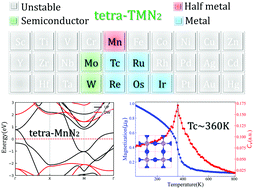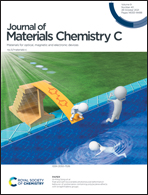High-throughput calculations of spintronic tetra-phase transition metal dinitrides†
Abstract
Two-dimensional (2D) transition metal dinitrides (TMN2) have attracted increasing attention owing to their diverse geometry configurations and versatile properties. Because of the large electrostatic repulsion between highly charged N3− ions, TMN2 could show a low-coordination-number geometry different from transition metal dichalcogenides (e.g. MoS2), which would bring about high-temperature ferromagnetism and other unique properties. In this study, we systemically investigated the possible h-, t- and novel tetra-phases of 2D TMDNs (TM = all the 3d, 4d and 5d transition metals) via high-throughput first-principles calculations. The results show that the 2D tetra-phases for several systems are energetically preferred than their h- and t-phases. These 2D tetra-phases are dynamically and thermally stable with comparable mechanical properties to 2D MoS2 and germanene. Tetra-MoN2 and tetra-WN2 are semiconductors, while tetra-TcN2, tetra-RuN2, tetra-ReN2, tetra-OsN2 and tetra-IrN2 are metals. In particular, tetra-MnN2 exhibits ferromagnetic half-metallicity with a Curie temperature (Tc) of up to ∼360 K and out-of-plane magnetic anisotropy. These findings expand the family of 2D TMN2 and provide a material database for future theoretical and experimental studies on 2D spintronic materials.



 Please wait while we load your content...
Please wait while we load your content...